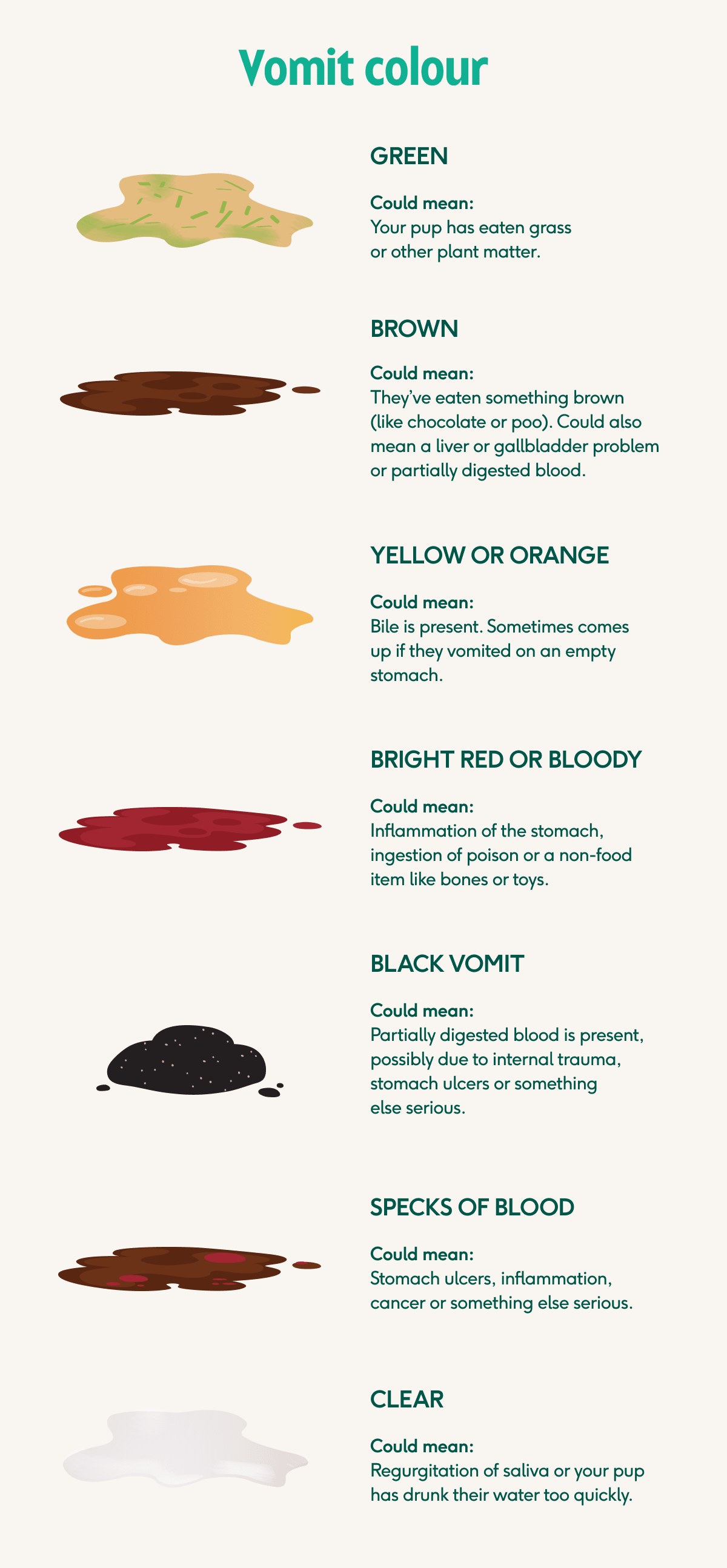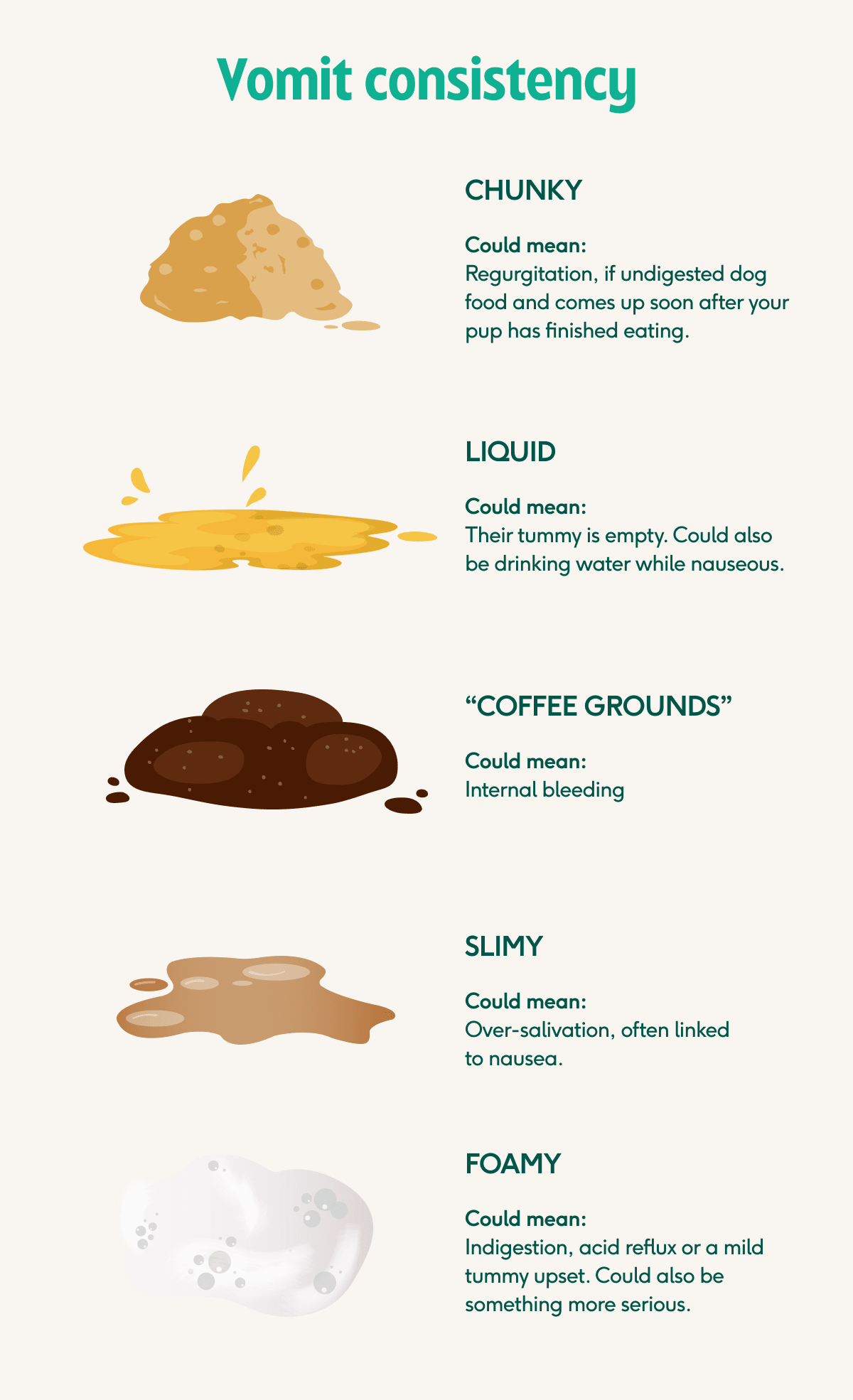There’s nothing worse than seeing your pup in discomfort after vomiting. If you’re confused about the cause, let’s investigate together.
According to Lyka’s in-house veterinary experts, vomiting can happen for many reasons. Upset tummies can sometimes result from eating processed foods, or could be a sign of something more serious.
Take a peek at our expert-backed charts to help you decide on next steps. They’ll explain the most common colours and textures you might encounter.
Top takeaways
Contact your vet if they’ve vomited more than twice in under 24 hours. It’s always better to be safe, especially if your dog is a senior or has a history of illness.
If your dog is also lethargic, losing weight, experiencing diarrhoea or passing bloody stools, this could mean there’s a bigger health issue that needs to be checked out.
Dogs eating dry or canned food are more prone to stomach upset. Fresh food has been proven as easier for dogs to digest.
Sniffing out the cause
Nobody likes to look at vomit for long, but take a mental note of its colour and texture. This can help clue you into the other health factors at play— and you’ll find most of them outlined in our charts below!
Hues and clues: understanding colour

Green vomit
Your dog may have eaten grass, rat sacks or plant matter. This can upset the stomach.
Next steps: Contact your vet, as some plants are toxic for dogs.
Yellow or orange vomit
Your dog’s liver produces bile to aid in digestion. This can show up in vomit if the stomach is empty.
Next steps: Try giving them a small meal to absorb any acid and bile. If they vomit more than twice or seem unwell, check in with your vet.
Brown vomit
They’ve either eaten something brown (like chocolate or poo) or it’s partially digested blood, which could mean problems with the liver, gallbladder or digestive system.
Next steps: If you think your dog has eaten chocolate, see your vet immediately. Keep an eye on it if you suspect it’s poo, and speak to your vet if it happens again.
Bright red or bloody vomit
If your poor pup is vomiting blood, they may have consumed poison or a non-food item like bones or toys — causing damage to their digestive tract. This could also point to a gastrointestinal disease or stomach inflammation.
Next steps: Contact your vet immediately.
Black vomit
Black, dark red or “coffee grounds” vomit could contain partially digested blood, which may be a sign of internal trauma, stomach ulcers, or an intestinal blockage.
Next steps: Contact your vet immediately.
Specks of blood in vomit
Specks of blood could be a sign of stomach ulcers, inflammation, digestion of foreign objects or toxins, liver or kidney disease, or cancer.
Next steps: Contact your vet immediately.
Clear vomit
Clear vomit is generally not a reason for concern. Their stomach is likely empty, and they’re regurgitating saliva or water that they’ve drunk too fast.
Next steps: Try feeding them a small meal, and keep an eye on it. If it’s more than a one-off, check with your vet.
Telltale textures: understanding consistency

Chunky vomit
Does it look like undigested dog food, or have they just eaten? This can mean regurgitation, which may be the case if your dog is eating too fast. It’s also possible that their stomach doesn’t agree with the food’s texture, and vomiting helps to soften it up.
Next steps: Keep an eye on the situation, but call your vet if it’s more than a one-off.
Liquid vomit
This may mean your pup’s tummy is empty, and they’re feeling nauseous after drinking water.
Next steps: Try feeding them a small meal. If it’s only happened once, this is not a cause for concern. If it continues, speak to your vet.
Slimy vomit
Over-salivation (and slimy vomit) often relates to nausea — which can happen for a variety of reasons, like anxiety or tummy troubles. The “slime” like texture could be mucus from your dog's stomach lining.
Next steps: Monitor your dog and speak to your vet if it happens again.
Foamy vomit
Foamy vomit could indicate indigestion, acid reflux, an upset tummy or gastrointestinal issues. It could also be a sign of pancreatitis, kennel cough, or something more serious like bloat or poison (which is often accompanied by liquid vomit containing bile).
Next steps: Keep an eye on it, and seek the guidance of your vet if it’s more than a one-off vomit.
“Coffee grounds” vomit
This is likely digested blood and could indicate internal bleeding.
Next steps: Contact your vet immediately.
Vomiting when transitioning to new foods
Vomiting is never normal for dogs, but it can happen once or twice when switching to new foods. Generally, this is temporary and not cause for concern. It’s often a sign of an upset tummy, as the microbiome adjusts to ingredients it may not be used to.
With that said, it’s always best to monitor your pup for signs of anything more serious.
What’s not normal during the transition period?
If your dog shows any of the below symptoms or you’re in doubt, pause the transition and speak to your vet. They might suggest a slower transition to the new food.
Vomiting more than twice.
General signs of not feeling well (like reduced energy levels, not eating, or not drinking).
Vomiting is more common amongst pups with sensitive stomachs or a history of gastrointestinal issues. They may require a slower transition to any new food. If you need help navigating the transition process to Lyka, have a chat with our friendly Customer Care team. This service is only available for Lyka customers.
FAQs
Still have questions on your mind? Our in-house veterinary team is on hand with the answers!
If you’re a customer, you can always reach out to Lyka’s Customer Care team for support.
How can I settle my dog’s tummy?
First, cut back on anything that could be a little too rich for their gut to handle. Stick to feeding a bland diet with ingredients like sweet potato. It’s rich in fibre and high in antioxidants, making it the perfect fix for an upset tummy.
Next, focus on gut health! A mix of pre and probiotics can help restore balance in their gut bacteria. Our Go-To Gut Helper is a powerful blend of live microbes, designed to improve digestive health.
Could my pup have a food intolerance?
Yes, vomiting can suggest that your dog’s stomach is rejecting certain foods. Allergy-induced spews can happen hours or days after the fact… this is why it’s best to keep an eye out for other signs of intolerance like itching. Most commercial dog foods contain fillers and food additives, which can be pro-inflammatory — causing skin and digestive issues in some dogs.
How a fresh food diet can help with vomiting and gut issues
Fresh dog food tends to be better quality, containing zero mystery ingredients while bursting with superfoods and nutrients. Just ask Louie, who struggled with digestive issues until she switched to fresh food. Check out Louie’s full story to learn more.
)
If your pup can’t seem to keep their food down, download our comprehensive guide or contact our Customer Care team if your pup is on Lyka. No topic is off limits: whether it’s poos, spews, or anything else on your mind.


)
)








